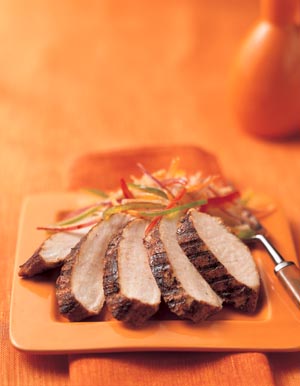SPICE BUYER’S JOURNAL DESTINATION: INDIA
 |
| Cumin Seasoned Pork Chops |
CUMIN Field Report – SPRING 2007
McCormick’s chief spice buyer, Al Goetze, travels to exotic ports-of-call, trekking across varied terrain in search of the finest herbs and spices. In this journal entry, Al explains the versatility, history and cultivation of cumin, and invites us inside his recent trip to India, the largest grower and consumer of this incomparable spice.
What is it about cumin that makes this spice so unique? Its very distinctive flavor is described as slightly bitter and warm, with strong, earthy notes. A quick whiff of cumin and you instantly know its identity. But, did you know that cumin is among the top 10 selling spices in the U.S? That’s not so surprising if you think about how important cumin is to some of our favorite flavors, like taco seasoning, chili powder and other Mexican and Southwest-inspired dishes. Cumin is also an essential ingredient in virtually every global cuisine, particularly the more trendy foods of North Africa, India and the Middle East.
Cumin seed has an extensive history and the foods that it is used to flavor today actually traces its fascinating past. Earliest records of cumin date back more than 4,000 years to its farming in the Nile River Valley and cultivation by the Egyptians. From there the seeds were bartered through overland camel trading routes crossing Northern Africa to the west and Asia to the east. As trade expanded, cumin was carried north into Europe via Morocco and Venice. Cumin reached the New World, with the arrival of the Spaniards in Mexico. Each stop along the way, the local population became intrigued with cumin’s flavor, and found ways to incorporate the spice into their dishes.
To get a firsthand view of this season’s cumin seed crop, I travel to northwest India to the states, Gujarat and Rajasthan. I meet up with my local colleague, Sibi, in Ahmadabad and drive over four hours to get to the growing region. This part of India is flat, with fields and grasses on both sides of the road as far as the eye can see. Cumin grows in the mild winter months, as the moisture and cool temperatures are ideal. The harvest takes place from March to May. It is critical that the weather becomes dry at harvest time. Hard rains can cause seeds to fall to the ground or turn black in color, resulting in a lower quality crop. This year, the crop is looking great — the farmers have planted a very large quantity and the weather has been ideal.
Cuminum cyminum is a delicate-looking annual, with slender, branched stems. It is a small, fast growing plant seldom reaching higher than three feet. Tiny white flowers will yield cumin seeds, which range in color from pale brown to khaki. Cumin seeds are similar in appearance to caraway seeds, averaging about ¼ inch in length. It grows in temperate climates and is harvested just four months after planting. It’s amazing that such an unassuming plant produces a seed so packed with flavor and aroma.
The farmers manually harvest the seeds by pulling the whole plant out of the ground and thrashing the seeds off of the plant onto a cover. Then, they are sun-dried and hand-sifted over a screen to separate out stems and twigs.
Most seeds are taken to a small town called Unjha which has a famous open air market, where merchants sell small lots of several hundred pounds of cumin seeds, one lot at a time. Even in the spring months here, the weather can get very warm, so the market closes for two hours mid-day. We were invited to eat at a local merchant’s house. The meal was comprised of many colorful dishes, both meat and vegetarian. My favorites were the curries that had an ample amount of cumin, fresh from the market! After our bountiful meal, we had a siesta to regain our strength for the afternoon at the market and the long drive back to Ahmadabad.
Back at home, I like to combine cumin with chili pepper, oregano and garlic for a flavorful spice rub — exceptional on grilled pork.
I look forward to sharing my next journey with you, and wish you a flavorful season!
